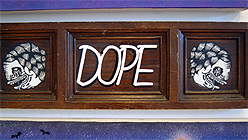What’s your ideal plan after you graduate?
MA: Not to conform or get a normal job, and to keep painting. I’ve been on this drive to paint more murals. I’d like to continue showing work in galleries, and skate my whole life until I can’t walk.


How are skating and art intertwined for you?
MA: I don’t think I’d be making art if it wasn’t for skateboarding. That’s truth. I always drew and skated at the same time; I would get the Flameboy or Wet Willy stickers and redraw them because I thought they were rad. Now, I’ll be painting and need a rush or something to get me out of the painting box, and skateboarding is that release. It just helps me. In a weird way, skateboarding is like performance art. When you land a trick, whether you get it on film or not, it’s ephemeral. If you were there, you were there.


What are some cultural influences in your work?
MA: I lived with my grandparents my whole life. They’re from Cuba and practice Santería, white and black magic. They aren’t evil witches, they practice white magic, and that’s been a great influence; parts of it have symbolically entered into my art. I was into Peruvian Shamanism for a while, so that comes into play. Religion, of course, because it all has to do with Catholicism, where Santería branched off from. Also sex because it’s just human nature, skateboarding, and mostly just the people I hang around with.


What kinds of mythology or other symbols show up in your work?
MA: The skull came subconsciously at first, but the more I read about subjects like black and white magic, I realized why I was making the skulls and putting them up around the city. In indigenous cultures, people would put human skulls in front of their homes to ward off evil. Almost like how Westerners originally put pumpkins in front of their houses for the same reason. Especially in the Caribbean, witches would use human skulls and bones to purify the area. I also use a lot of snakes, which is funny, because in Western culture, snakes make people think of the Bible; the snake being a devilish creature who lures people into evilness. But snakes in most indigenous cultures, especially in Peru, are just really pure and closest to the earth. I’ve been into this motto of “montanan la serpiente,” riding the snake. Everyone’s riding the earth, this Ouroboros kind of mythology. It’s a revolving circle of cruel realities that we just kind of have to make positives out of.




What other animal symbolism are you working with?
MA: Over the summer, I felt like I was in this cave-ish hole out in the Inland Empire, where I’m from. If you’ve ever been to the IE, you know it’s definitely a black hole. I’ve seen a lot of people go down the wrong path there. My friend and I have a Star Wars philosophy where people are divided into Siths and Jedis. There’s nothing wrong with both. The goal is to meet in the middle and be half and half. The bat represents Sith life; people leaving this cave. It’s an evil-looking creature, but it doesn’t mean any harm at all. I’ll also use owls, I’ll hide them in places. They’re smalls symbols of wisdom that are creeping; they’re never fully there. It’s like that Jiminy Cricket in the back of your mind.


You usually put up installations with your paintings, tell us about those.
MA: As you can see in my studio space, I like to create an environment. I see my space and places where I get to show work as a chance for me to expand. I want to give more of an environmental feel to my mystical-looking landscapes and creatures. I’m trying to make people almost feel like they’re in the paintings, with little objects coming out of the wall to give an illusion.

What is the soundtrack to your art?
MA: Duke Ellington, “Train A,” [sic] that’s been in my mind lately. If I’m printmaking, I’ll definitely listen to something fast that hypes me up like Brotha Lynch Hung or Gangstarr. If I’m painting, I’m usually in a romantic, sentimental mood, so it’ll be Charles Mingus or Charlie Parker — something more vibey like that.



















